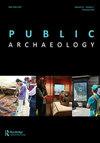Editorial
IF 0.9
4区 历史学
0 ARCHAEOLOGY
引用次数: 0
Abstract
In the opening paper of this double issue, David Gill provides an overview of the development of guidebooks of the Ministry of Works, the forerunner to the current UK heritage preservation bodies. While museum catalogues have been frequently used in art historical research to understand the development of curatorial practices, by contrast, guidebooks have generally been an under-utilized resource, albeit with few notable exceptions, such as Jocelyn Anderson’s recent studies of Country Houses guidebooks (2011; 2018) and Amara Thornton’s work on archaeological publishing (2018). Gill provides one of the first analyses of this material relating to UK heritage sites. His paper shows how theMinistry of Works responded to increasing popular interest in its archaeological sites and historic buildings, from the initial introduction of guidebooks by the Ministry in 1918 up to the reconfiguration of its responsibilities as English Heritage, in 1983. Gill demonstrates the changing nature of these publications in response to varying forms of public engagement. The value of studies such as this lies in the treatment of guidebooks as artefacts of changing consumption patterns at heritage sites, and their utility as signifiers of the way in which sites are packaged for visitors. While interpretation panels, shop merchandise, and corporate branding exercises come and go — and often escape the clutches of the archive — the mass market nature of guidebooks ensures that copies survive, providing a snapshot into prevailing attitudes towards the public. Moreover, the longitudinal study that this type of material affords can help offer insights into the perennial discussions surrounding the perception that organizations like English Heritage are ‘dumbing down’ their interpretation to sate a wider audience. In the following paper, Qioawei Wei and Luo Zhao provide an overview of the development of public archaeology in China through the implementation of that country’s National Archaeology Parks project. The authors contextualize this project by first discussing the history of archaeological outreach in China; a history that deserves to be better known and that has important implications for our predominantly Western understanding of public engagement with archaeology. The authors discuss the introduction of the concept and discipline of ‘public archaeology’ into China from the early 2000s, and how this has been adapted to the Chinese context. The National Archaeology Parks are administered by the State, and as such have the weight of bureaucratic muscle behind them to ensure their rapid implementation — since 2009, thirty-six parks have been inaugurated across China and more are planned. Generally speaking, these parks appear to be a useful resource for promoting the importance of the preservation of archaeological sites as a scientific and cultural endeavour. The limitations, of course, on the development of public archaeology in China is its critical focus. While these parks have public archaeology, Vol. 16 Nos. 3–4, August–November 2017, 129–131社论
在这两期的开篇文章中,David Gill概述了工程部指南的发展情况,工程部是目前英国遗产保护机构的前身。尽管博物馆目录经常被用于艺术历史研究,以了解策展实践的发展,但相比之下,指南通常是一种利用不足的资源,尽管很少有明显的例外,例如Jocelyn Anderson最近对乡村住宅指南的研究(2011;2018)和Amara Thornton的考古出版工作(2018)。Gill提供了第一批与英国遗产地有关的材料分析。他的论文展示了工程部如何应对公众对其考古遗址和历史建筑日益增长的兴趣,从1918年工程部最初推出指南到1983年重新配置其作为英国遗产的职责。Gill展示了这些出版物在不同形式的公众参与下不断变化的性质。这类研究的价值在于将指南视为遗产地不断变化的消费模式的艺术品,并将其作为为游客包装遗址的象征。虽然解说小组、商店商品和企业品牌活动来来往往,而且往往逃脱了档案馆的控制,但指南的大众市场性质确保了副本的生存,从而提供了对公众普遍态度的快照。此外,这类材料提供的纵向研究有助于深入了解长期以来围绕着这样一种观点的讨论,即像英国遗产这样的组织正在“降低”他们的解释,以满足更广泛的受众。在下文中,Qioawei Wei和Luo赵通过国家考古公园项目的实施,概述了中国公共考古的发展。作者首先讨论了中国考古外展的历史,将这个项目置于背景之下;这段历史值得我们更好地了解,对我们以西方为主的公众参与考古的理解具有重要意义。作者讨论了“公共考古”的概念和学科从21世纪初引入中国,以及如何适应中国的背景。国家考古公园由国家管理,因此,国家考古公园背后有强大的官僚力量来确保其快速实施——自2009年以来,中国已有36个国家考古公园落成,并计划建设更多国家考古公园。总的来说,这些公园似乎是一种有用的资源,可以促进考古遗址保护作为一项科学和文化事业的重要性。当然,中国公共考古发展的局限性是其关键所在。虽然这些公园有公共考古,第16卷第3–4期,2017年8月至11月,129–131
本文章由计算机程序翻译,如有差异,请以英文原文为准。
求助全文
约1分钟内获得全文
求助全文

 求助内容:
求助内容: 应助结果提醒方式:
应助结果提醒方式:


